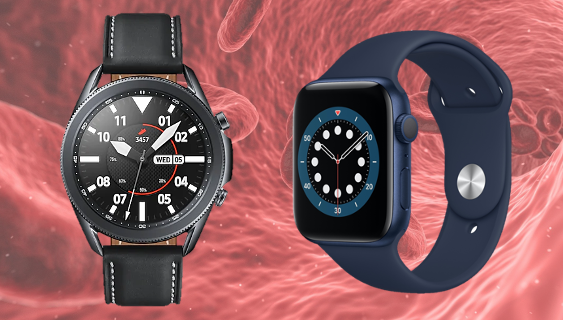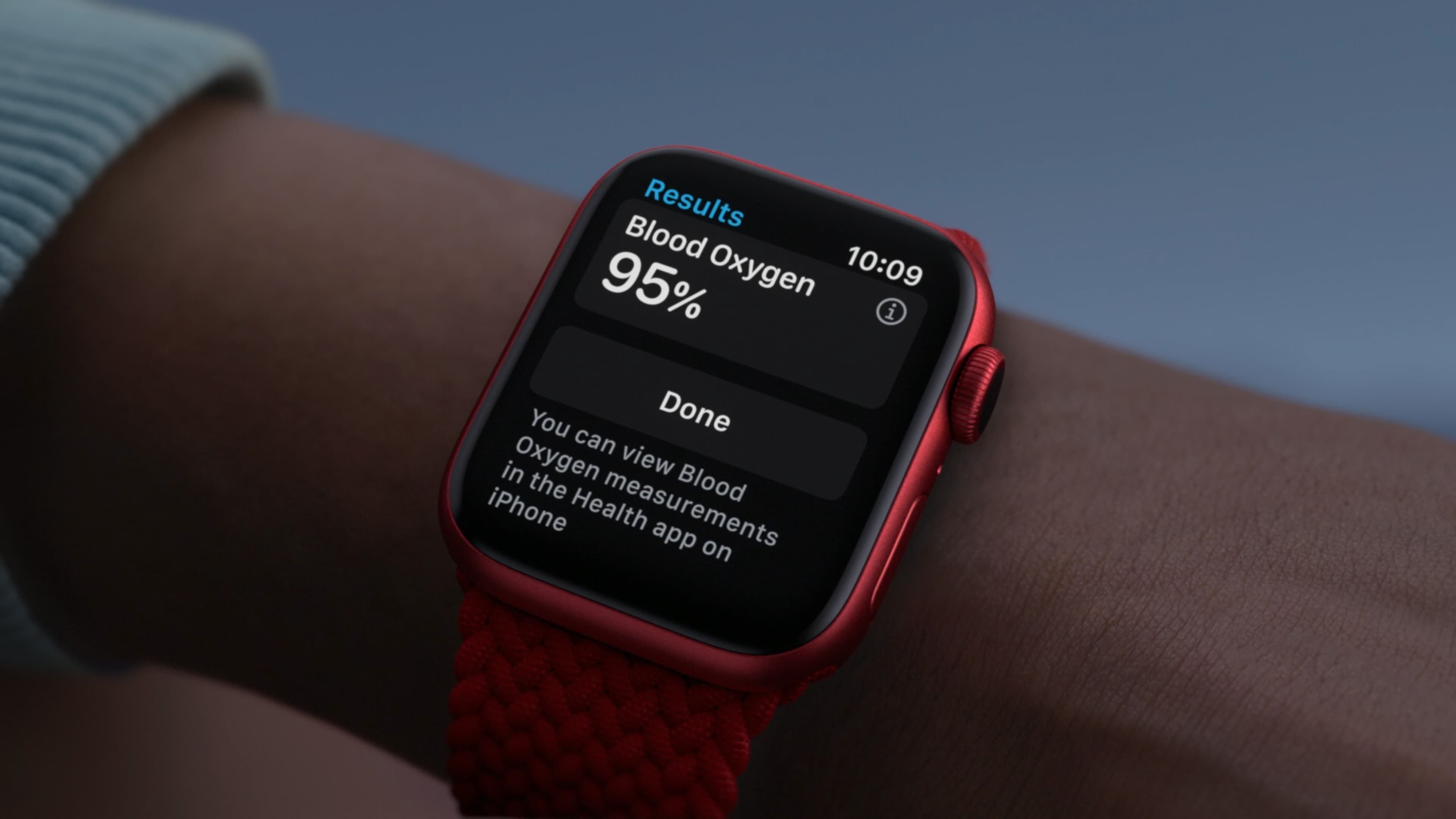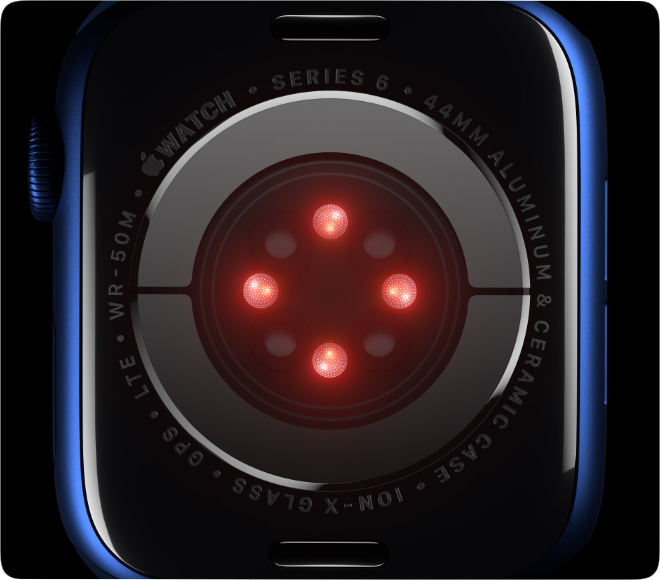The Apple Watch Series 7 offers the same suite of sensors as the Series 6. These include an accelerometer, a gyroscope, a heart rate sensor, a barometer, an always-on altimeter, a compass, an SpO2 sensor, and a VO2 max sensor. These sensors have a host of health and fitness tracking features, including blood oxygen monitoring, heart rate monitoring, sleep tracking, fall detection, workout tracking, and more.
Additional features include a new S6 processor that is up to 20% faster than the S4 and S5, a 2.5× brighter always-on display, and an always-on altimeter. The Series 6 watch was updated with faster charging hardware such that it completes charging in ~1.5 hours. Force Touch hardware was removed, consistent with the removal of all Force Touch functionality from watchOS 7. Apple today announced Apple Watch Series 7, featuring a reengineered Always-On Retina display with significantly more screen area and thinner borders, making it the largest and most advanced display ever. The narrower borders allow the display to maximize screen area, while minimally changing the dimensions of the watch itself. With the improvements to the display, users benefit from the same all-day 18-hour battery life,1 now complemented by 33 percent faster charging.
Compared to much older models, the Apple Watch Series 7 definitely seems like a major upgrade. But if you're currently using the Apple Watch Series 6, feel free to pass up on Apple's latest smartwatch release. The Series 7 's sensors, features, and even battery life are all borrowed from its predecessor and it didn't get any significant upgrades that are exclusive to it. While it is more durable and has a bigger screen, a full keyboard, and faster charging time, these incremental improvements don't seem enough to justify an upgrade from the Series 6. The ECG system has received clearance from the United States Food and Drug Administration, a first ever for a consumer device, and is supported by the American Heart Association. This device can also detect falls and will automatically contact emergency services unless the user cancels the outgoing call.
The microphone was moved to the opposite side between the side button and the digital crown to improve call quality. Other changes include the digital crown incorporating haptic feedback with the Apple Haptic Engine and includes the new Apple-designed W3 wireless chip. Both Series 6 and 7 are an improvement when compared to the SE. The Apple Watch SE features the 2nd gen optical heart sensor and skips on the blood oxygen sensor.
It also has poorer fall detection and lacks cycling detection. All three watches feature an always-on altimeter, GPS, gyroscope, and ambient light sensor for other health and tracking features. You get the new Apple S7 SiP powering the Apple Watch Series 7, but there is no performance improvement here. Apple says this new processor is on par with the previous-gen S6 SiP in the Series 6. The Series 7 supports dual-band Wi-Fi, Apple's U1 chip, and ultra wideband antennas. It has health sensors for blood oxygen and heart rate tracking as well as the hardware to record an ECG.
Just like the Series 6, the new Series 7 also has an always-on altimeter that can track elevation changes constantly. The fall detection feature now also works while tracking workouts. The Series 7 is also equipped with new hardware that enables ultra-rapid, short-range wireless data transfer at 60.5 GHz, though Apple has not fully explained this new functionality. The S7 SiP with 64-bit dual-core processor is up to 20% faster than the S5 in Apple Watch SE.12 The always-on altimeter detects your elevation in real time.
It lacks fairly basic features like interval sessions and heart rate alerts. The 6 and 7 have the same array of sensors, including a blood oxygen sensor, an electrical heart sensor, a third-generation optical heart sensor, GPS, and a barometric altimeter. The Apple Watch Series 7 charges 33% faster than the Apple Watch Series 6.If you're hoping for longer battery life, you'll be sorely disappointed because Apple deprived the Apple Watch Series 7 of that upgrade. Like its predecessor, the Series 7 still can't go beyond 24 hours like many other smartwatches out there and can only manage 18 hours per charge. But not all is lost because at least the Series 7 can charge 33% faster than the Series 6, thanks to the magnetic fast-charging USB cable that ships with it.
This improvement should come as good news to those who like to track their sleep because you only need to charge it for a couple of minutes to enjoy 8 hours of monitoring. When the Apple Watch Series 6 first came out, it blew us away with its fast processor, bright display, and ability to measure blood oxygen level. But now that the new Apple Watch Series 7 is here, the time has come to decide whether we should leave the Series 6 behind.
Apple seems to have given the Series 7 a curvier silhouette, thinner bezels, and a bigger screen but are there more substantial improvements that can really justify an upgrade? To help you answer this question, here's an in-depth comparison of the two Apple Watch models, covering their design, display, features, and battery life. The Apple Watch Series 7 is powered by an S7 SiP , which is a rebranded S6 SiP from Series 6; watchOS 8 performance is identical on Series 6 and 7. Apple continues to make incremental improvements to the Apple Watch and that makes sense as it is one of the most popular wearables in the world. It's a fast, reliable smartwatch that helps manage both health and fitness.
A new QuickPath keyboard was announced which will probably be available for the Apple Watch Series 6 as well. Overall, the big changes to the Apple Watch Series 7 are almost entirely related to the screen, becoming larger, brighter, and more durable. While that is one of the most important aspects of the watch, the lack of new sensors means Apple Watch Series 6 owners should probably wait for the next generation. The Apple Watch Series 7 is a significant upgrade when compared to even earlier models and will offer good value if upgrading.
It may not be significantly better, but the Galaxy Watch 4 Classic does offer better battery life than its competitor. Rather than 18 hours, you'll get around 40 hours of battery life. This means you can expect to charge every other day or so, depending on your usage. The drawback is that you won't have a fast charging cable, so you can expect it to take longer to reach a full charge. It easily outperforms Google Wear OS-based watches like the Moto 360, and offers a much more fully realized smartwatch experience than Fitbit's more health-centric models. If you already own a Series 5, the Series 6 is really only worth the upgrade if you absolutely must have the always-on altimeter or SpO2 readings.
The Watch SE, which shares design elements with the Series 6, along with key health and safety features like fall detection, starts at $279 for the GPS-only model or $329 for the GPS and cellular version. It lacks an always-on display, as well as blood oxygen saturation and electrocardiogram readings—we go into detail on the differences between the two watches here. TechRadar gave it a score of 4.5/5, calling it one of the top smartwatches, while criticizing the short battery life.
Digital Trends gave it a score of 5/5, calling it Apple's best product and praising the design, build quality, and software, among others, while criticizing the battery life. CNET gave it a score of 8.2/10, calling it the "best overall smartwatch around", while criticizing the battery life and lack of watch face options. T3 gave it a score of 5/5, calling it a "truly next-gen smartwatch" due to its thinner body and bigger screen compared to the Series 3, and health features. Apple has also made some significant improvements to battery life and charging on the Apple Watch Series 7.
The company claims that the new smartwatches offer 18-hour all-day battery life, along with 33% faster charging than the previous model. In the past, Apple's watchOS looked similar across all its smartwatches, minus select apps exclusive to the new hardware inside a given model. Apple Watch 7 doesn't have new sensors, though, so instead the company altered watchOS 8 for a bigger screen. Apple's latest smartwatch is mostly an incremental upgrade from the Apple Watch 6, maintaining an 18-hour battery life, the same CPU and adding no new health features. But the enlarged display is game-changer, and makes it difficult to return to previous-generation models. The Series 7's big screen adapts wearable computing for more everyday applications, making it practical to be productive from your wrist.
It's worth noting that all of these features - except the always-on altimeter - can be found on the Series 4 and 5 too. So, the difference between the two generations of Apple's smartwatches boils down to the importance placed on the larger display, the reduced charging time, water-and-dust resistance, and color options. If one has already made up one's mind, there is no persuading otherwise.
Apple's sixth-generation wearable, the Apple Watch Series 6, arrived with a brighter always-on display mode. Naturally, the processor became faster than that of the earlier models and a new sensor was added. Blood oxygen measurement is useful in the diagnosis of some medical conditions, most notably sleep apnea, although Apple states that its sensor should not be used for that purpose. Instead, it gives a general idea of how well blood is oxygenated when at rest. Given that there is little variation, almost always between 95 and 100-percent, the value of this sensor is much less than that of the heart rate sensor and ECG capability.
That meant the Apple Watch Series 6 was not a huge upgrade over the previous generation. All the Watch models being compared here have built-in GPS, optical heart rate sensor, speaker, microphone, water resistance up to 50 metres, emergency SOS, gyroscope and an ambient light sensor. The Apple Watch Series 7 doesn't have an official release date yet, and by all indications, it's pretty similar to last year's model.
Apple Watch 6 Vs 7 Vs Se The most significant difference is the Apple Watch Series 7 has a bigger screen and thinner bezels, making the Apple Watch Series 6 screen look smaller side-by-side. Not to mention that the Series 7 comes in two slightly bigger case sizes — 41mm and 45mm — making the device just a bit bigger than the Series 6. The Apple Watch Series 7 is a minimal upgrade on the inside, but the new larger display with thinner bezels looks gorgeous. While it has the same battery life as last year's model, the Series 7 has a USB-C charging cable included in the box that charges the watch up to 33% faster, so you'll spend less time juicing up than before.
Overall, the Apple Watch Series 7 is a minor upgrade over the Apple Watch Series 6, offering larger displays and casing sizes, new color options, improved durability, the S7 chip, and faster charging. These features are mostly iterative improvements rather than major reasons to upgrade, and the Series 7 does not add any new functionality. There is also the Apple Watch Series 3, which Apple sells for $199.
This older model offers substantially fewer features and has a smaller screen. The Apple Watch Series 3 is still a capable device, with 8GB of storage, water-resistance up to 50 meters, an altimeter, Emergency SOS, and an optical heart sensor. Functionally, it is more pared back than the Apple Watch SE, being thicker with larger bezels.
Now, although Apple will not officially sell the Apple Watch 6, users can still buy the previous-gen Apple Watch from third-party resellers until stocks last. So, which one should you get if you are in the market for an Apple Watch? Well, if you want the latest and greatest from Apple, we recommend you go for the latest Apple Watch 7. The larger display, dust resistance, and faster charging are reasons enough to convince prospective buyers.
Otherwise, if you don't care much about these minor upgrades and just want the Apple Watch experience, go with Apple Watch 6, which will now sell at reduced prices. Apple claims 18 hours of battery life on the Apple Watch Series 7, and I was able to get about a day and a half worth of use on a single charge. It was set to monitor my heart rate throughout the day, with the always-on display mode enabled, and SpO2 tracking on by default. During this time, the watch was connected to my iPhone at all times. I did also manage to get just about two days' worth of battery life with the always-on display switched off.
Using the Series 7's cellular capability resulted in a drop in battery life as I expected. The Apple Watch has been our longstanding Editors' Choice for its excellent performance, unparalleled app selection, and ample health and fitness tracking features. When it comes to fitness tracking, there are no differences either, at least on paper. The Series 6 has the same health and fitness tracking sensors as the newer watch. You get a pulse oximeter, ECG, separate GPS, and an optical heart rate sensor on both models.
Initial reviews for the device have been generally positive with some caveats. Reviewers praised the watch's potential ability to integrate into everyday life and the overall design of the product, but noted issues of speed and price. Many reviewers described the watch as functional and convenient, while also noting failure to offer as much potential functionality as preceding smartphones.
Farhad Manjoo of The New York Times mentioned the device's steep learning curve, stating it took him "three long, often confusing and frustrating days" to become accustomed to watchOS 1, but loved it thereafter. Some reviewers also compared it to competing products, such as Android Wear devices, and claimed "The Smartwatch Finally Makes Sense". He concluded that there is no "killer application" so far besides telling the time, which is the basic function of a wristwatch anyhow. Force touch technology has been removed in Watch Series 6 and Watch SE. The watch also has a side button which can be used to display recently used apps and access Apple Pay, which is used for contactless payment. The watch then reverts to its original mode when recharged or after holding down the side button.
Secondly, in the case of the Series 7 , the Digital Crown has an electrical heart rate sensor built into it, which is in addition to the optical heart rate sensor on the underside of the watch. The Watch Series 7 also has a blood oxygen sensor, like the Series 6, and it has reduced bezels surrounding the display, as well as an IPX6 dust resistance. The catch is that the screen isn't as sharp and impressive as the Apple Watch's, and you don't get the full Apple ecosystem experience with iPhones and other Apple devices. The Apple Watch SE, in contrast to its more expensive counterparts, packs an optical heart rate sensor, fall detection, an always-on altimeter. Unlike the last few generations of flagship wearables, it does not have a blood oxygen sensor or an electrocardiogram.
As for fitness tracking, there are also no differences, at least on paper. The Series 6 has the same fitness- and health-tracking sensors as the newer watch. You get a pulse oximeter, ECG, standalone GPS, and an optical heart rate sensor on both models. One of the main determining factors when choosing between the Samsung Galaxy Watch 4 Classic and Apple Watch Series 7 will come down to your preferred operating system.
Some Apple users may be willing to buy the Series 7 for the few upgrades it offers. You get a refined design with a larger display, a full keyboard, faster charging, and better brightness indoors. However, if these features aren't important to you, then you might want to stick with your older Apple Watch. One of the biggest improvements has to do with the health sensors. The Galaxy Watch lineup is no stranger to advanced health tracking, but there's more to it with the new models.
The Galaxy Watch 4 Classic is equipped with a three-in-one BioActive sensor that houses multiple chips in one. You'll still be able to take numerous measurements, including ECG, heart rate, blood oxygen, and Bioelectrical Impedance Analysis . Choosing between Apple and Samsung is like choosing between apples and oranges. They're both smartwatches, but they cater to different crowds.
If you're an Android user who's looking for a solid upgrade that offers a stylish aesthetic, you'll probably lean toward the Samsung Galaxy Watch 4 Classic. It comes in two sizes, has advanced health sensors, and runs on the new Wear OS 3 platform. You can rest assured this is one of the best Android smartwatches you can buy right now. Fitbit's latest smartwatches may offer fewer features than the Apple Watch, but they deliver battery life of three days or longer, which comes in handy when you're tracking sleep. Unfortunately, there aren't too many things to get excited about when it comes to the Series 7 as its features are very similar to its predecessor's. Just like the Series 6, the Series 7 comes with an ECG and a blood oxygen sensor, as well as Apple's staple health and safety features like workout tracking, sleep monitoring, emergency SOS, and noise monitoring.





























No comments:
Post a Comment
Note: Only a member of this blog may post a comment.